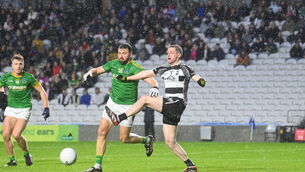Fans must wait as GAA remains off limits for all bar the chosen few

Fans look on during the Cork v Galway hurling league game recently. Picture: INPHO/Ryan Byrne
WHEN Attila Fiola scored Hungary’s goal against France just before half-time in last Saturday’s Euro 2020 game in Budapest, he jumped a pitch-barrier in the packed Puskas Arena, smashed down on a commentary table before celebrating wildly with the Hungarian players and supporters.
It was the best goal celebration of the Euros to date, but it was also unique in how some supporters were so intrinsically connected to the emotion of the moment; as his team-mates wrapped themselves around Fiola, a handful of fans were able to partake in the embrace as they reached in from the stand.
The Puskas Arena was rocking. The 61,000 supporters in the stadium was three times the number of spectators (18,497) who were allowed to attend other Euro 2020 fixtures up to that point of the competition.
Prime Minister Viktor Orban is a huge football fan and the Hungarian FA made the bold decision to pack their national stadium for its games based upon their government’s ambitious and ever-growing vaccination programme. Everyone in the ground had been vaccinated, producing a vaccination card on entry.
There have been some incredible moments in the Euros, but Fiola’s goal was probably the standout one because of how it reminded everyone of what sport has missed over the last 16 months.

Sport in Ireland is still a long way from packed stadiums and ecstatic crowd celebrations, but at least crowds are returning, in some capacity. Last weekend’s Division 3 League football final, and the National League camogie final, saw crowds in Croke Park for the first time since the pandemic struck.
The camogie finals and at least one football league final, along with this Saturday’s ladies National League Division 1 and 2 finals in Croke Park were initially targeted as pilot crowd events. The other designated GAA pilot events are next Saturday’s Cork-Limerick Munster hurling semi-final, and the Connacht meeting between Roscommon and Galway at Dr Hyde Park, Roscommon the following day.
It’s still early days but with the vaccination rollout and the vaccination effect proceeding across society, capacity at the games will steadily increase from 10%, to 20%, to 33%, with the aim of reaching 50% by the autumn.
“We want to see as many spectators return as quickly as possible,” said Jack Chambers, Minister of State for Sport and the Gaeltacht recently on RTÉ’s Morning Ireland. “We’re ambitious around that and that’s why we’re doing the pilots, to get the logistics and the systems right so we can then expand capacity through the summer.”
Last October the GAA, IRFU and FAI compiled a report and plan, where a collaborative working group wanted a common message from all three organisations.
Their document, ‘Guidelines for Reopening Sports Grounds,’ laid out the protocols that would be observed once spectators were allowed to return, including that the relevant stadium or sports ground will become a ‘controlled environment’ as defined by Nphet.
Everyone wants to get spectators back, but the Government have been consistent in their timeline for doing so. With UEFA having a minimum capacity for their stadiums to be at least 25% full, Dublin’s Euro 2020 games were moved to Russia and London as the FAI and the Government were unable to guarantee spectator attendance. With UEFA’s stadium capacity requirements, the Government couldn’t sanction 11,000 supporters in June as a starter event.
LIMITED
As things currently stand in the GAA – outside those pilot events – only 100 supporters can go to matches in smaller venues, with that number rising to 200 at venues that can hold more than 5,000.
The pilot events will give the scope to increase those numbers, but, even at outdoor events, all the other measures are still in place - face masks, social distancing and contract tracing protocols. There is also staggered entry and exit times, as well as a new code of conduct for ticket holders.
With the championship back this weekend, the scramble for match tickets has gone to a whole different level again. Trying to source All-Ireland final tickets was a doddle compared to the current demand. Because the supply is effectively non-existent.
For the biggest game of the first championship weekend, the Clare-Waterford Munster hurling quarter-final, only 200 will be permitted into Thurles. Drilling down into those numbers though underlines the scale of the task of distribution.
Both competing counties receive just 80 tickets, but that figure includes additional squad players and backroom members, which will account for around 20 tickets.
With the matchday group of 40 – 26 players, management, backroom and two county executives – receiving one ticket each, that leaves just 20 tickets for various sponsors, who would normally get at least twice that amount.
The Covid numbers here are similar to those in Denmark, but when Denmark whacked Russia in the Euros last Monday night, there were upwards of 23,000 fans in the Parken Stadium in Copenhagen.
Nobody wants that here, especially with the new Delta variant of the virus, but it’s harder for GAA supporters to sit back and watch on when beaches and parks are thronged over the summer, and particularly when big stadiums are ‘controlled environments’.
For the moment at least, GAA supporters just have to take the pain and continue to watch their teams from the TV. Attendances will incrementally increase but, with a knockout football championship and with hurling teams only guaranteed two games, the vast majority of counties will be gone out of the championship before any meaningful crowds do return.
In any case, full stadiums, and exhilarating scenes like those witnessed in Budapest last weekend, are still a long, long way off here.








 App?
App?










